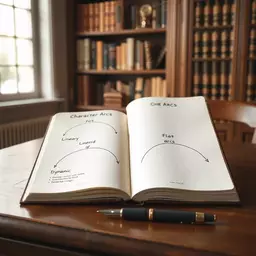Character Arcs Explained Simply
By Clara Eastwood / Nov 11
Crafting a compelling narrative begins with a solid foundation, and a well-structured outline serves as that crucial bedrock. Have you ever felt adrift in your creative process? A structured outline not only organizes your thoughts but also streamlines your writing journey. Let’s explore the essentials of outlining your novel and how it can transform your storytelling experience.
Understanding the advantages of a well-structured outline can significantly enhance your writing process. Below are the primary benefits illustrated in a visual format.
A good outline helps you see your story's overall structure and themes.
It ensures that each scene serves a purpose and transitions smoothly.
Writing becomes faster and more focused when you know where you're headed.
It reveals any areas that need more development before you start writing.
As a writer, you may have found yourself overwhelmed by the vastness of your ideas. This is where a well-structured novel outline becomes essential! Having a clear outline not only organizes your thoughts but also paves the way for a smoother writing process. Think of it as the roadmap guiding you through your story's twists and turns. If you're just starting your first novel, a solid outline can be incredibly helpful for starting your first novel together successfully.
When I'm working on a new project, I find that taking the time to outline helps me clarify my vision. It's a crucial step that allows me to spot potential plot holes and inconsistencies early on. Plus, a solid outline increases my confidence, making it easier to dive into writing without second-guessing each decision!
Outlining your novel is like setting up your tent before a camping trip. Without it, you might end up lost in the wilderness of your own ideas! Here are some key reasons why outlining is so important for writers:
At Fiction Frameworks, we emphasize the value of outlines in transforming scattered ideas into cohesive narratives. By following a structured format, you can breathe life into your writing projects while keeping your creativity intact!
Successful storytelling hinges on structure, and that's where outlines play a vital role. They act as the backbone of your story, helping you connect your characters, themes, and plot points seamlessly. When your outline is clear, you can focus on the creative aspects of writing, like character development and dialogue.
Consider this: an engaging story often has well-defined arcs and satisfying resolutions. By mapping these out in your outline, you create a blueprint for reader engagement! For instance, understanding creating compelling character arcs is crucial for this process. Here are some essential elements to consider when crafting your outline:
With a clear outline, you can weave these elements together effectively, making your story both compelling and satisfying. As I dive into my outlines, I often reflect on how they guide me toward creating stories that resonate with readers!
Ready to start your outlining journey? Let’s break it down step by step. Creating a solid novel outline might feel intimidating, but by following a structured approach, it becomes much more manageable!
As I guide you through this process, remember that Fiction Frameworks provides templates designed to simplify this very task. So grab your favorite notebook, and let's get started!
When creating your outline, consider using a mind mapping tool. This visual approach can help you brainstorm and organize your ideas in a non-linear way, allowing for greater creativity and flexibility in your storytelling. It’s particularly useful for visual learners and can uncover connections you may not have initially considered!
When it comes to outlining your novel, visual aids and resources can significantly boost engagement and understanding. At Fiction Frameworks, we believe that seeing the process in action makes a world of difference. Incorporating various types of media not only helps clarify concepts but also keeps the creative juices flowing!
One effective way to enhance your outlining journey is through video tutorials. These engaging formats break down complex ideas, allowing you to follow along as you learn how to make the most of templates. Seeing the tools in use can transform your approach, making outlining feel less daunting and more achievable.
Video tutorials provide a dynamic way to engage with the outlining process. They can show you exactly how to use Fiction Frameworks’ fill-in-the-blank templates, which can be a game changer for many writers!
These resources empower you to harness the tools available and discover new ways to outline your novel effectively. Plus, watching someone else navigate the process can offer insights that may spark ideas for your own work!
Worksheets are another fantastic resource. They allow you to actively engage with the outlining process rather than just passively absorbing information. Here are a few ways to make the most of these interactive tools:
By using these worksheets, you can refine your ideas and create a robust outline that captures the heart of your story. It’s all about making the writing process more tangible and structured, which is a core tenet of what we do at Fiction Frameworks.
Don’t underestimate the power of community when it comes to your writing journey! Participating in workshops can provide you with valuable feedback and fresh perspectives. At Fiction Frameworks, we encourage writers to connect with one another and share their experiences.
These interactions can not only inspire you but also keep you motivated as you embark on your novel-writing journey. Remember, writing is often a solitary endeavor, but it doesn’t have to be! For more insights into structuring your story, consider exploring effective plotting tools for writers.
Now that we've explored various resources and techniques to enhance your outlining process, it's clear that having the right tools can make a significant difference. Whether it’s through video tutorials or interactive worksheets, taking advantage of available resources will help you create a well-structured novel outline.
As you embark on this outlining adventure, I invite you to tap into the wealth of downloadable templates available at Fiction Frameworks. These tools are designed to simplify your writing process and empower you to transform your ideas into fully-fledged narratives.
Here’s a quick recap of the key points we’ve discussed:
These strategies will not only enhance your outlining skills but also boost your confidence as a writer!
Ready to take your outlining to the next level? Don’t hesitate! Head over to Fiction Frameworks today and download the templates that will help you craft your story with clarity and creativity. Your novel awaits, and you have the tools to make it happen! To learn more about how templates can benefit your writing, check out using templates for fiction writing.
Here is a quick recap of the important points discussed in the article:
A: Outlining helps clarify your vision, enhances story flow, boosts writing efficiency by keeping you focused, and allows you to identify plot holes or areas needing development early in the process. It acts as a roadmap for your entire narrative.
A: An outline ensures that each scene and plot point serves a purpose and transitions smoothly into the next, creating a coherent and engaging narrative structure for your readers.
A: Yes, by planning your story beforehand, you'll have a clear direction, reducing instances of writer's block, extensive rewrites, and getting stuck on inconsistencies, making your writing sessions more focused and productive.
A: Essential elements include the protagonist's journey, the main conflict(s) that drives the story, and the resolution of these conflicts, along with how characters grow and change throughout the narrative.
A: Absolutely! Tools like mind mapping software, writing worksheets for character sketches and plot development, video tutorials on template usage, and community writing workshops can significantly aid your outlining process. Fiction Frameworks also offers downloadable templates.

 Character Arcs Explained Simply
Every compelling story resonates with readers because of the evolution of its characters. Whether it
Character Arcs Explained Simply
Every compelling story resonates with readers because of the evolution of its characters. Whether it
 Outline Your Novel with Templates
Have you ever been stuck staring at a blank page, unsure of where to start? Outlining your novel can
Outline Your Novel with Templates
Have you ever been stuck staring at a blank page, unsure of where to start? Outlining your novel can
 Plotting Fiction: Strategies That Work
Did you know that a well-structured plot can make the difference between a reader putting your book
Plotting Fiction: Strategies That Work
Did you know that a well-structured plot can make the difference between a reader putting your book